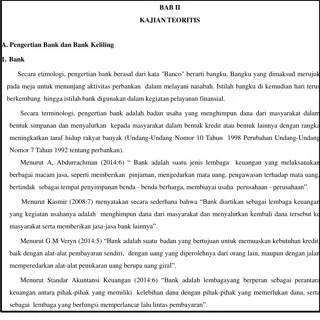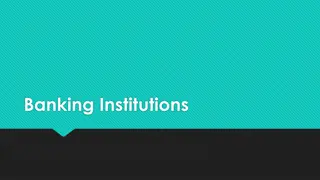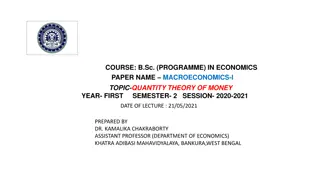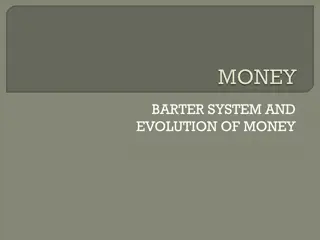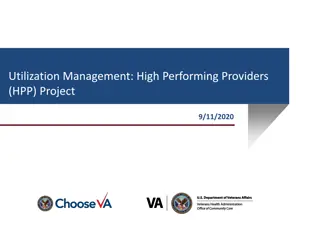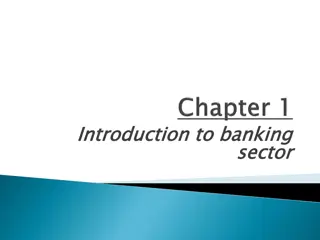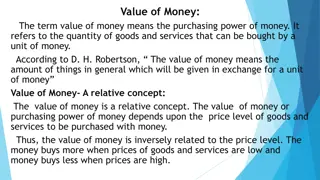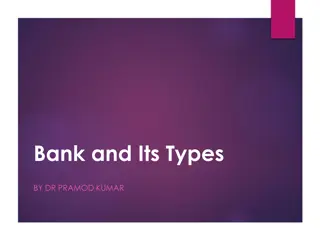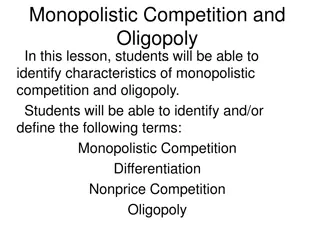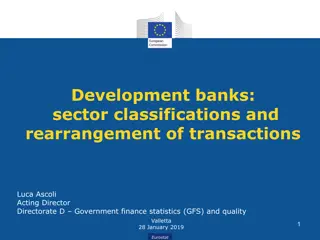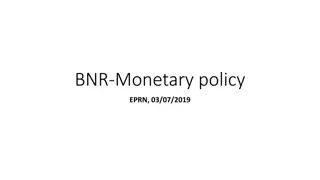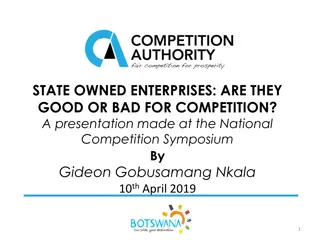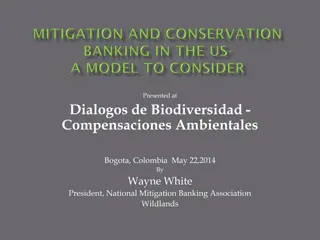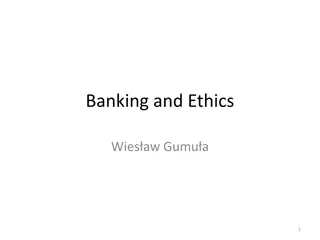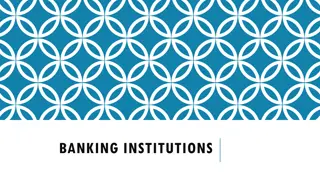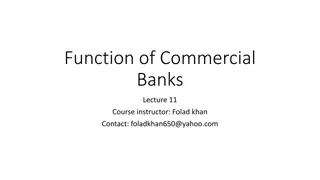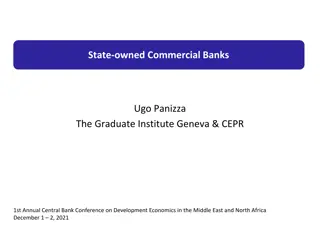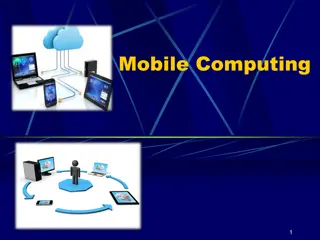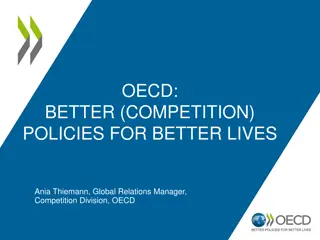Competition among banks and mobile money providers
Facilitating economic growth through financial sector development in developing countries is crucial. This study explores how incumbent banks and new entrants compete in the expanding digital financial services landscape. Assessing complementarity and substitution between traditional banks and mobile money providers sheds light on consumer preferences and market dynamics.
Download Presentation

Please find below an Image/Link to download the presentation.
The content on the website is provided AS IS for your information and personal use only. It may not be sold, licensed, or shared on other websites without obtaining consent from the author.If you encounter any issues during the download, it is possible that the publisher has removed the file from their server.
You are allowed to download the files provided on this website for personal or commercial use, subject to the condition that they are used lawfully. All files are the property of their respective owners.
The content on the website is provided AS IS for your information and personal use only. It may not be sold, licensed, or shared on other websites without obtaining consent from the author.
E N D
Presentation Transcript
Competition among banks and mobile money providers Ryan Hawthorne, Zubair Patel CRESSE, 6 July 2024 Contact: info@acaciaeconomics.com 24 Cradock Avenue, Rosebank, 2196, South Africa 1
Table of Contents Introduction Model Data Results Counterfactuals Conclusions 2
Financial sector development is important in developing countries Financial sector development facilitates economic growth (Levine, 2005), Including by expanding digital financial services (Khera et al, 2021) An important barrier to the uptake of financial services is affordability, whichmay be impacted on by competition Mobile money providers are expanding, and digitalbanks are entering We study how incumbent banks and new entrants compete using a unique dataset 4
Model 5
Model We specify the deterministic component of consumer ? s stand-alone utility (???) from a bank or mobile money service (?) as follows, as follows: ???= ??+ ????+ ????+ ????? Where: ???denotes alternative specific variables (such as bank or mobile service) that have a generic coefficient ?. ??refers to individual characteristics (such as age, income). ???refers to alternative specific variables (such as monthly bills) that have an alternative specific coefficient. 6
Assess complementarity and substition between mobile and traditional In respect of Eswatini and Lesotho, we are able to assess whether bank and mobile money products are substitutes, complements, or independent of each other, following the approach in Gentzkow (2007). Utility derived by consumer ? from each choice bundle ? is as follows: ???= ???if ? = 0 and ? = 0 ???= ???+ ???if ? 0 and ? = 0 ???= ???+ ???if ? = 0 and ? 0 ???= ???+ ???+ ???+ ???if ? 0 and ? 0 7
Gammas identify substitution or complementarity In our setup, consumers must choose between banks (they are not permitted to have more than one bank), and between mobile operators (they cannot have more than one), and between combinations of one bank and one mobile operator. If alternative ? is preferable to alternative ?, then: ? ??< ?? ??+ ?? = ? ? ?? ??+?? Where ? ??< ?? ??+ ?? is the probability that the deterministic component of utility (??) obtained from option ? is greater than that obtained from all other alternatives (?). 8
Assume errors are independently and identically distributed We assume that the error term for each alternative (??) follows the Gumbel distribution and we assume that errors are identically distributed. The main idea with the multinomial logit model is that we are interested in differences between choice alternatives, rather than the absolute utility obtained from each alternative. We can write down the probability that alternative ? is chosen following the logit probability: ??? ??= ???? 9
Choice alternatives By changing prices, which impact on the deterministic component of utility (?), and - introducing additional choice alternatives (?), we are able to simulate the impact of changes in probabilities for choosing different alternatives. The number of choice alternatives (?) varies by country. For example: In South Africa, there are six choice alternatives: no bank, ABSA, Capitec, FNB, Nedbank, and Standard Bank. In Lesotho, there are nine choice alternatives: no provider, Ecocash, FNB, Mpesa, Standard Bank, FNB and Mpesa, FNB and Ecocash, Standard Bank and Ecocash, Standard Bank and Mpesa. Using our model, which depends on prices (monthly bills) and demographic characteristics, we are able to predict which alternative is chosen by each consumer in each country. 10
Data 11
Finscope demand side survey, UNCDF price data Nationally representative demand side surveys were developed by FinMark Trust, and funded from a range of sources, including the Making Access Possible (MAP) initiative, in specific countries tied to MAP programming. The resulting datasets contain demographic and livelihoods information alongside detailed financial services usage and behaviour information. The second collection of datasets is from a research study conducted by Africa Analysis, commissioned by UNCDF s MAP programme collecting prices of various bank products and services (up to 105 fee lines are captured) in 35 countries in Africa and Asia (covering the SADC, WAEMU and ASEAN regions). The banks available in the pricing datasets are also available in the FinScope datasets for the countries that were matched for this study. The bank pricing data is from 2016 to 2022 and was collected based on bank products and services targeted at low socio-economic consumers, middle socio-economic consumers, and small businesses. 12
Lesotho (2021) -consumer choice of providers (FinScope, weighted) 13
Monthly bills are calculated for the choice alternatives for each consumer Monthly bills are computed based on consumer usage of services The following bank pricing variables were used from the UNCDF dataset: Monthly fee: Monthly Account Fee Billpayfee: Internet Banking: Funds Transfer (to other banks) Merchant fee: POS: Point of Sale Purchases Cash out fee: Withdrawal (own bank ATM)/ per 100 USD The following mobile money fees were used for eSwatini and Lesotho: Billpay(Lesotho: M251-M500 (M-Pesa) & M201-M300 (EcoCash); Eswatini: E251-E500 (MTN MoMO)) Payments to merchants were assumed to be via person to person transfers (Lesotho: M251-M500 (M-Pesa) & M201-M300 (EcoCash); Eswatini: E251- E500 (MTN Momo))1 Cash out (Eswatini: 20-125; Lesotho: M51-100) 14
Results 16
Term Estimate Standard error Statistic p-value Estimation results - Lesotho monthly_bill -0.0013 0.0016 -0.8083 0.4189 mpesa 0.6836 0.0897 7.6209 0.0000 ecocash -2.0281 0.1302 -15.5733 0.0000 fnb -0.9685 0.1281 -7.5629 0.0000 bank_age_35_below -1.6336 0.3278 -4.9836 0.0000 mobile_age_35_below 0.4308 0.0848 5.0784 0.0000 bank_rural -3.5825 0.2689 -13.3215 0.0000 mobile_rural -0.8092 0.0908 -8.9130 0.0000 bank_income_poor -2.7983 0.5901 -4.7425 0.0000 mobile_income_poor 0.0036 0.0934 0.0382 0.9695 bank_income_high -1.1461 0.3931 -2.9153 0.0036 mobile_income_high -0.1163 0.1217 -0.9552 0.3395 bank_high_school -2.6536 0.6092 -4.3557 0.0000 mobile_high_school -0.3706 0.1213 -3.0556 0.0022 bm -2.1341 0.1806 -11.8172 0.0000 bm_age_35_below 1.1381 0.3690 3.0846 0.0020 bm_high_school 3.2646 0.6354 5.1375 0.0000 bm_rural 2.6884 0.3347 8.0332 0.0000 bm_income_poor 1.3441 0.7004 1.9191 0.0550 bm_income_high 2.0976 0.4035 5.1983 0.0000 17
Predicted and actual probabilities -Lesotho Provider Actual Predicted ecocash 0.0282 0.0319 fnb 0.0048 0.0108 fnb_ecocash 0.0041 0.0011 fnb_mpesa 0.0190 0.0160 mpesa 0.4839 0.4802 none 0.4179 0.3889 standard 0.0048 0.0277 standard_ecocash 0.0034 0.0027 standard_mpesa 0.0340 0.0407 18
Term Estimate Standard error Statistic p-value Results - Eswatini monthly_bill -0.0006 0.0110 -0.0506 0.9596 mtn 0.8252 0.1018 8.1036 0.0000 fnb -3.5208 0.7134 -4.9356 0.0000 nedbank -5.6333 0.7745 -7.2736 0.0000 standard -4.1305 0.7349 -5.6205 0.0000 swazibank -5.3806 0.8596 -6.2593 0.0000 bank_age_35_below -0.6456 0.6364 -1.0146 0.3103 mobile_age_35_below -0.0860 0.0906 -0.9488 0.3427 bank_income_poor -1.0086 1.1667 -0.8645 0.3873 mobile_income_poor* -0.6979 0.0953 -7.3247 0.0000 bank_income_high 1.8821 0.7733 2.4338 0.0149 mobile_income_high -0.1030 0.1760 -0.5851 0.5584 bank_female -2.0124 1.0575 -1.9030 0.0570 mobile_female 0.4351 0.0907 4.7999 0.0000 bank_high_school 0.5707 0.7033 0.8115 0.4171 mobile_high_school 0.8568 0.1056 8.1168 0.0000 bm -0.3369 0.7720 -0.4364 0.6625 * Having 50% lower income than the `poor , as defined by UNCDF bm_age_35_below 0.9983 0.6815 1.4650 0.1429 bm_female 1.9649 1.0849 1.8112 0.0701 bm_high_school 0.2338 0.7744 0.3019 0.7627 bm_income_poor -0.0322 1.2490 -0.0257 0.9795 19 bm_income_high -0.8380 0.8119 -1.0322 0.3020
Results -Botswana Term Estimate Standard error Statistic p-value monthly_bill -0.0054 0.0016 -3.3342 0.0009 bank_income -0.0000 0.0000 -2.5613 0.0104 20
Results -South Africa Term Estimate Standard error Statistic p-value monthly_bill -0.0013 0.0004 -3.0773 0.0021 absa -1.3423 0.0359 -37.3904 0.0000 nedbank -1.7112 0.0417 -41.0412 0.0000 fnb -1.1118 0.0339 -32.7767 0.0000 standard -1.5775 0.0401 -39.2987 0.0000 bank_income 0.0000 0.0000 11.7747 0.0000 bank_female -1.6759 0.0293 -57.1611 0.0000 21
Counterfactual simulation 30%lower prices: Lesotho Provider Actual Predicted (model) Predicted (lower price) ecocash 0.0282 0.0319 0.0319 fnb 0.0048 0.0108 0.0109 fnb_ecocash 0.0041 0.0011 0.0011 fnb_mpesa 0.0190 0.0160 0.0162 mpesa 0.4839 0.4802 0.4796 none 0.4179 0.3889 0.3879 standard 0.0048 0.0277 0.0282 standard_ecocash 0.0034 0.0027 0.0028 standard_mpesa 0.0340 0.0407 0.0415 23
Counterfactual simulation -lower prices: Eswatini A 30% price reduction has very little impact on uptake Provider Actual Predicted (model) Predicted (lower price) fnb 0.0014 0.0019 0.0019 fnb_mtn 0.0110 0.0106 0.0106 mtn 0.6991 0.6991 0.6990 nedbank_mtn 0.0039 0.0006 0.0006 none 0.2729 0.0033 0.0033 standard 0.0021 0.2729 0.2729 standard_mtn 0.0046 0.0010 0.0010 swazibank 0.0007 0.0057 0.0057 swazibank_mtn 0.0043 0.0008 0.0008 nedbank 0.0000 0.0042 0.0042 24
Counterfactual simulation -lower prices: Botswana A 30% price reduction has very little impact on uptake Provider Actual Predicted (model) Predicted (lower price) absa 0.0767 0.2414 0.2430 bancabc 0.0196 0.2397 0.2418 fnb 0.2543 0.2414 0.2430 none 0.6493 0.2775 0.2723 25
Counterfactual simulation -lower prices: South Africa A 30% price reduction has very little impact on uptake Provider Actual Predicted (model) Predicted (lower price) absa 0.0628 0.0628 0.0633 capitec 0.0956 0.2401 0.2422 fnb 0.0777 0.0777 0.0788 nedbank 0.0441 0.0441 0.0443 none 0.6706 0.5260 0.5216 standard 0.0492 0.0492 0.0497 26
Counterfactual simulation -entry: Lesotho A new Fintech entrant (FNB less 20% prices) would gain only a small share possibly due to widespread use of mobile money Predicted (model) Predicted (lower Predicted (new Provider Actual price) entry) ecocash 0.0282 0.0319 0.0319 0.0316 fnb 0.0048 0.0108 0.0109 0.0102 fnb_ecocash 0.0041 0.0011 0.0011 0.0011 fnb_mpesa 0.0190 0.0160 0.0162 0.0158 mpesa 0.4839 0.4802 0.4796 0.4756 none 0.4179 0.3889 0.3879 0.3863 standard 0.0048 0.0277 0.0282 0.0263 standard_ecoca sh 0.0034 0.0027 0.0028 0.0027 standard_mpesa 0.0340 0.0407 0.0415 0.0402 fintech 0.0103 27
Counterfactual simulation -entry: Eswatini A new Fintech entrant (FNB less 20% prices) would gain only a small share possibly due to widespread use of mobile money Predicted (model) Predicted (lower Predicted (new Provider Actual price) entry) fnb 0.0014 0.0019 0.0019 0.0018 fnb_mtn 0.0110 0.0106 0.0106 0.0104 mtn 0.6991 0.6991 0.6990 0.6979 nedbank_mtn 0.0039 0.0006 0.0006 0.0006 none 0.2729 0.0033 0.0033 0.0033 standard 0.0021 0.2729 0.2729 0.2726 standard_mtn 0.0046 0.0010 0.0010 0.0010 swazibank 0.0007 0.0057 0.0057 0.0057 swazibank_mtn 0.0043 0.0008 0.0008 0.0008 nedbank 0.0000 0.0042 0.0042 0.0042 fintech 0.0018 28
Counterfactual simulation -entry: Botswana A new fintech entrant in Botswana (FNB less 20% price) would gain far higher traction Predicted (model) Predicted (lower Predicted (new Provider Actual price) entry) absa 0.0767 0.2414 0.2430 0.1938 bancabc 0.0196 0.2397 0.2418 0.1925 fnb 0.2543 0.2414 0.2430 0.1938 none 0.6493 0.2775 0.2723 0.2235 fintech 0.1965 29
Counterfactual simulation -entry: South Africa A new fintech entrant in SA (FNB less 20% price) would gain far higher traction Predicted (model) Predicted (lower Predicted (new Provider Actual price) entry) absa 0.0628 0.0628 0.0633 0.0575 capitec 0.0956 0.2401 0.2422 0.2197 fnb 0.0777 0.0777 0.0788 0.0711 nedbank 0.0441 0.0441 0.0443 0.0404 none 0.6706 0.5260 0.5216 0.4940 standard 0.0492 0.0492 0.0497 0.0450 fintech 0.0724 30
Conclusions 31
Bank and mobile money services are substitutes We estimate a discrete choice model of demand for banking and mobile money services for Botswana, Eswatini, Lesotho, and South Africa. There is some evidence that bank and mobile money services are substitutes in at least Lesotho. However, the degree of substitution is weakened particularly for younger consumers and consumers in rural areas, who are likely not in a position to use banking services as readily as a substitute. 32
Entry has a greater impact than lower prices in Botswana, South Africa Our counterfactual simulations show that while reductions in monthly bills will increase uptake of banking services to a small degree, the uptake of mobile services would not increase substantially. Introducing a new fintech entrant that is cheaper than banking services would: Likelyattract a onlya small market share in Eswatini and Lesotho (a mobile entrant would make more sense) but Would likely have a significant share in Botswana and South Africa. Indeed, we have observed successful entry by TymeBankin South Africa, which has attracted large numbers of customers in a relatively short space of time. 33



